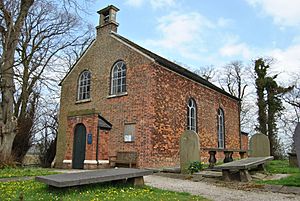Becconsall Old Church facts for kids
Quick facts for kids Becconsall Old Church |
|
|---|---|

Becconsall Old Church from the southwest
|
|
| Lua error in Module:Location_map at line 420: attempt to index field 'wikibase' (a nil value). | |
| OS grid reference | NZ 274 513 |
| Location | Hesketh Bank, Lancashire |
| Country | England |
| Denomination | Anglican |
| Website | Churches Conservation Trust |
| History | |
| Dedication | All Saints |
| Architecture | |
| Functional status | Redundant |
| Heritage designation | Grade II |
| Designated | 11 October 1968 |
| Architectural type | Church |
| Style | Georgian |
| Construction cost | £90 (£10,000 in 2021) |
| Specifications | |
| Length | 36 feet 6 inches (11 m) |
| Width | 24 feet (7 m) |
| Other dimensions | Sanctuary 8 feet (2 m) by 15 feet (5 m) |
| Materials | Brick, stone slate roof |
Becconsall Old Church is a very old church in Hesketh Bank, a village in Lancashire, England. It's not used for regular church services anymore. This special building is protected as a Grade II listed building. This means it's an important historical place. The church is looked after by a group called the Churches Conservation Trust. You can find it on a small road that leads to a boatyard near the River Douglas.
Contents
The Story of Becconsall Old Church
How the Church Was Built
The church you see today was built in 1764. It stands where an even older chapel used to be. That first chapel was built in the 1500s for the Becconsall family. Building the current church cost about £90 back then. This would be a lot of money today! Local farmers helped pay for most of it. The rest was paid by people living in the area.
Building Materials and Changes
The church was made using special handmade bricks. These bricks were given by Sir Thomas Hesketh, who owned the land. Later, in the 1900s, a small porch was added to the front of the church. The church is named All Saints.
Why It's an "Old Church"
In 1926, a brand new All Saints Church was built in a different spot. After that, the old church was only used for special events. It was used for funerals and a yearly service called "Old Church Sunday."
Damage and Repairs
During the Second World War, something fell in the churchyard. It damaged some gravestones and caused a little harm to the outside of the church. By 1985, the church was in very bad shape and had to close. In the 1990s, the Churches Conservation Trust took over. They fixed it up, and the church reopened in 1995. This meant "Old Church Sunday" services could happen there again.
What the Church Looks Like
Outside the Church
The church is built with red bricks and has a roof made of stone tiles. It has a simple rectangular shape. There's a small area at the back called a sanctuary. At the front, there's the porch, and a tiny room called a vestry is at the side. The main part of the church is about 36 feet long and 24 feet wide. The sanctuary is smaller, about 8 feet by 15 feet.
The porch has a round-shaped doorway. Above it, there are two round-shaped windows. On the very top of the front wall, there's a small bellcote. This is a little tower that holds a bell. On each side of the church, you'll see two big round-headed windows. At the very back, there's a large window with three parts, called a Venetian window.
Inside the Church
Inside, there's a gallery at the front. This is like a balcony supported by four wooden pillars. The font, which is used for baptisms, is from the 1700s. It looks like a vase and is made from a special material called Coade stone. You can also find a pulpit (where sermons are given), a lectern (for reading), some old pews, an altar, and wooden panels on the walls. The bell that was once removed from the bellcote has been put back by the Trust.
Other Interesting Features
The Sundial
In the churchyard, there is an old stone sundial from 1776. It has a square base and a brass plate on top. The part that casts the shadow, called the gnomon, is missing. This sundial is also a Grade II listed building, just like the church itself.
See also
- Listed buildings in Hesketh-with-Becconsall
- All Saints Church, Becconsall
- List of churches preserved by the Churches Conservation Trust in Northern England

